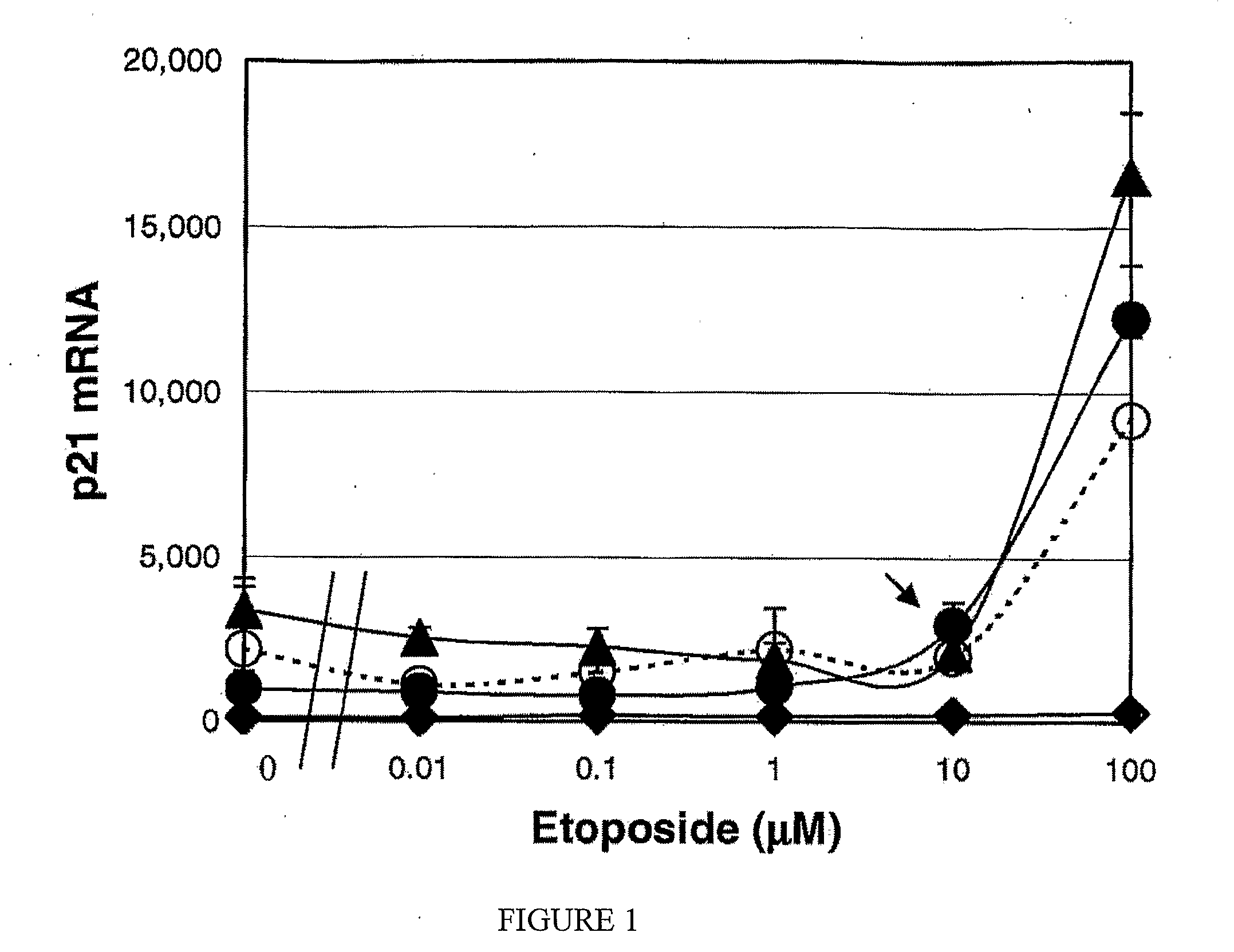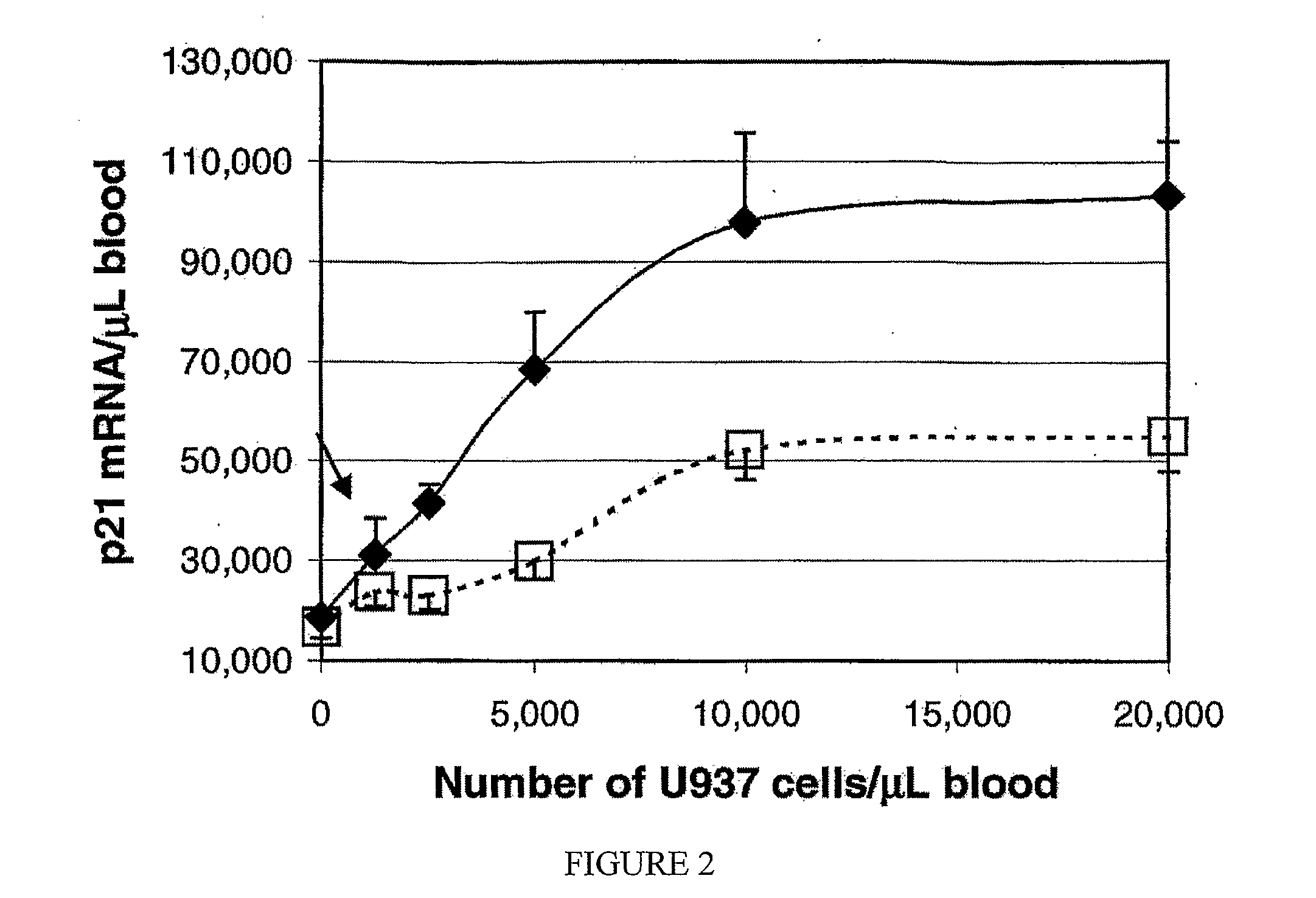Method for tailoring administration of drugs by quantitation of mRNA
a drug and quantitation method technology, applied in the field of tailoring administration of drugs, can solve the problems of not always correlated values, ungeneral practicability, and a large amount of time and resources
- Summary
- Abstract
- Description
- Claims
- Application Information
AI Technical Summary
Benefits of technology
Problems solved by technology
Method used
Image
Examples
embodiment 1
Use of p21 / BAX in Tailored Drug Administration For Leukemia and Lymphoma
[0060]In the present method, leukocyte cell death resulting from the action of pharmaceutical agents is linked to the transcription level of p21 and BAX mRNA. Of these two marker mRNAs, p21 is responsible for cell cycle arrest, and BAX is induced as an initial signal of apoptosis. If a drug induces p21 in cancer cells, it indicates that the drug exhibits cytostatic activity, whereas BAX induction means that the drug has cytocidal activity. Although many genes are involved during the processes of apoptosis, the expression of these 2 early gene markers indicate the cytotoxic activities of a drug.
[0061]Blood was obtained from healthy adults and from two leukemic non-Hodgkin's malignant lymphoma patients. U937, KG-1, and Jurkat cells were obtained from American Type Culture Collection (ATCC, Manassas, Va.), and maintained in RPMI 1640 supplemented with 10% fetal calf serum. Of these, U937 cells are a human histiocyt...
embodiment 2
Use of p21 and PUMA mRNA in Tailored Drug Administration for Leukemia and Lymphoma
[0071]PUMA or Bcl-2 binding component 3 (bbc3) was discovered by 3 independent groups at the almost same time in 2001, and given GenBank accession numbers HSU82987, AF332558, and AF354656, respectively. According to GenBank information, these sequences were submitted in December 1996, December 2000, and March 2001, respectively, and the oldest entry, UniGene (Hs.467020) used bb3 as the title of this gene. Many publications use PUMA (p53 regulated modulator of apoptosis), not bbc3. It is not universally expressed in all types of cells, and according to the expression profile data in UniGene (Hs.467020), it is expressed in blood, cervix, colon, eye, kidney, larynx, lung, mammary gland, ovary, skin, small intestine, stomach, and testis. PUMA has also been reported to be a major mediator of drug-induced apoptosis in mice. Although PUMA was characterized extensively in each experimental system, no link has ...
embodiment 3
Assessment of Leukocyte Suppression
[0085]Blood samples were obtained from healthy volunteers or patients with leukemia and lymphoma. Triplicate aliquots of 50 μL each of heparinized whole blood was incubated with various concentrations of anti-cancer drugs (BLM, VP-16, and taxol) for a specified length of time, then mRNA was purified, cDNA was synthesized, and the levels of p21, PUMA, and BAX were quantitated by TaqMan real time polymerase chain reaction (PCR), as described above. In brief, each blood sample was applied to 96-well filterplates to trap leukocytes. Lysis buffer containing artificial RNA (RNA34) and a cocktail of specific primers were added to filterplates, and cell lysates were transferred to oligo(dT)-immobilized microplates (GenePlate, RNAture, Irvine, Calif.) for hybridization. The DNA was then synthesized in the oligo(dT)-immobilized microplates without additional primers, and was used for TaqMan real time PCR in 384-well plates (Applied Biosystems, Foster City, C...
PUM
| Property | Measurement | Unit |
|---|---|---|
| pH | aaaaa | aaaaa |
| pH | aaaaa | aaaaa |
| SYBR green real time PCR | aaaaa | aaaaa |
Abstract
Description
Claims
Application Information
 Login to View More
Login to View More - R&D
- Intellectual Property
- Life Sciences
- Materials
- Tech Scout
- Unparalleled Data Quality
- Higher Quality Content
- 60% Fewer Hallucinations
Browse by: Latest US Patents, China's latest patents, Technical Efficacy Thesaurus, Application Domain, Technology Topic, Popular Technical Reports.
© 2025 PatSnap. All rights reserved.Legal|Privacy policy|Modern Slavery Act Transparency Statement|Sitemap|About US| Contact US: help@patsnap.com



